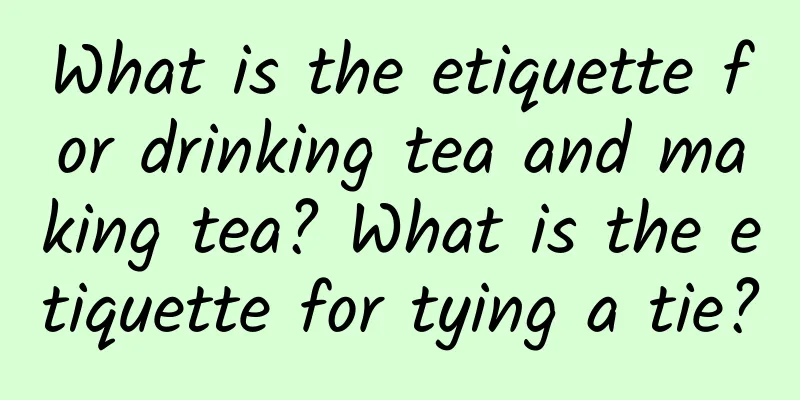What is the etiquette for drinking tea and making tea? What is the etiquette for tying a tie?

|
Etiquette accompanies every aspect of our lives, and it can also reflect a person's character and quality. It is very necessary. For example, the art of tea, and understanding when making and drinking tea also require great attention. There are also New Year's greetings, tying a bow tie, etc., which require us to accumulate and understand little by little. Contents of this article 1. What are the etiquettes for drinking and brewing tea? 2. What is the etiquette for tying a tie? 3. What are the etiquettes for New Year greetings during the Spring Festival? 1What is the etiquette for drinking tea?Generally, when pouring tea, you should not fill the cup too full, which is impolite. Because the tea is hot, if you fill it up, the cup will be very hot and it will easily burn the guests' hands, causing inconvenience to the guests. Usually, when you see the elders at home making tea, they will pour 70% of the tea and serve it to the guests. This way, they will not burn the guests. When pouring tea for guests, you should pour tea for the elders first, then for the younger ones. The order of pouring tea should be to respect the elders first and then the younger ones. Then say "Please have some tea" to the guests. When serving tea, one should also pay attention to seniority, serving the elders first, then the younger ones. If there are guests, one should serve the guests first, then the host, serving tea to the guests first, then to one's own family members. When brewing tea, the first brew is used to wash the tea leaves and must be poured out and not drunk. Because the tea leaves have passed through many hands during the production process, in order to prevent the tea leaves from getting dirty, they must be washed once before they can be drunk. Therefore, in life, we will pour out the first brew of tea, and only the first brew of tea will be poured for the guests to drink. If you let the guests drink the first brew of tea, it is very impolite and means to insult the guests. When a new guest arrives during tea drinking, the host should immediately pour out the tea in the teapot and replace it with new tea to welcome the new guest. Otherwise, it will be considered as "disrespecting the guest". And after changing the tea, the host should still pour out the first cup of tea, brew the second cup of tea, and then serve the tea to the new guest first. There are also etiquettes for guests to accept tea from the host. If the host is a junior, and he pours tea for an elder, the elder should tap the table twice with his index finger to show his gratitude after accepting the tea. If the host is an elder or a peer, and he pours tea for a peer or a junior, the peer or junior should tap the table twice with his index and middle fingers to show his gratitude. When entertaining guests, the host should also pay attention to refilling the guests' tea. If the guest's teacup is empty, remember to refill the guest's teacup with tea. If the tea in the guest's teacup has not been drunk for a long time and has become cold, the cold tea in the guest's teacup should be poured out and replaced with hot tea. When refilling the guest's tea, if there is tea residue in the guest's cup, the host should wash the cup for the guest and replace it with hot tea. 2What is the etiquette for tying a tie?1. When wearing a tie, you should pay attention to the occasion. In casual occasions, you usually don't need to wear a tie. Choose different ties for different occasions. In festive occasions, the color of the tie can be brighter. In solemn occasions, black or other plain ties are generally worn. In daily life, you can wear a tie even if you only wear a long-sleeved shirt, but you don't need to wear a tie when you wear a short-sleeved shirt. 2. Pay attention to the position of the tie. The tie should be placed between the suit and the shirt; if you wear a suit vest or cashmere sweater, it should be placed between the shirt and the vest or cashmere sweater. 3. Pay attention to accessories. Even if you use a tie clip, it should not be in the sight of outsiders, but only clip it on the "golden section" after the tie is tied, that is, between the fourth and fifth buttons from the top of the shirt. If you want, you can also use a tie pin or tie rod for a large tie. The former should be inserted in the center of the upper part of the tie after it is tied, while the latter can only be used on the shirt collar. 3What are the etiquettes for Chinese New Year greetings?1. Bowing: The posture of bowing is to hold your hands together and raise them forward. You cannot hold your hands randomly. Men should hold their left hands, that is, men should hold their right hands with their left hands. This is called "auspicious bowing", and the opposite is "unlucky bowing". On New Year's Day, holding your left hand with your right hand is unlucky. When performing the ceremony, regardless of status, you should hold your hands up to your eyebrows and shake them up and down a few times. For serious etiquette, you can bow after bowing. This etiquette is generally used by younger generations to greet elders, or by subordinates to greet their superiors. 2. Holding the fists and bowing: This is a traditional etiquette unique to the Chinese nation. Holding the fists means holding the right hand with the left hand, naturally clasping it together with appropriate tightness, and shaking the hands slightly in front of the chest naturally, not too strong or too high. This etiquette is often seen in New Year greetings between peers. 3. Wanfu: A kind of etiquette for ancient women. The right hand covers the left hand, half-clenched, and placed between the right waist and ribs. The woman shakes up and down a few times, and squats slightly with both knees. Sometimes, the woman says Wanfu while performing the ceremony. It is rarely used in modern times. 4. Bowing: A common modern etiquette, used for New Year greetings, mostly between younger generations to older generations, and subordinates to superiors. It can also be used between peers, by both men and women. |
<<: Why should babies learn etiquette? When should we teach babies etiquette?
>>: Drink bone soup to supplement calcium? Don't tell your mother this heartbreaking truth
Recommend
What age is amenorrhea normal?
For many women, menstruation is an existence that...
How much does a cervical film cost?
Cervical erosion is a relatively common gynecolog...
Dryness after vaginal delivery
Many women who have just given birth are very res...
Will my waist ache in the first 1-2 weeks of pregnancy?
You may experience lower back pain in the first o...
What novel is Dream Back to the Qing Dynasty adapted from? Dream Back to the Qing Dynasty txt Baidu cloud resources
Before the winter and summer holidays every year,...
When is the best time to wear a pelvic correction belt and how to use it
Why do we say that the butt is big after giving b...
What are the best places to visit during the 2022 Spring Festival? When does the 2022 Spring Festival start?
It is still unpredictable whether the epidemic wi...
How to maintain ovaries and uterus
Every woman hopes that she can stay young and bea...
What are the consequences of cupping during menstruation?
It is best for female friends not to cupping duri...
Six symptoms remind you that vertigo is coming
Vertigo is a common symptom that many people have...
What should I do if my eyelids are drooping? Do I need treatment?
Some people's eyes in life It's always li...
Symptoms of uterine infection after cesarean section
In the medical field, cesarean section and natura...
Can women use cupping during menstruation?
Cupping, acupuncture, moxibustion, etc. are all t...
What should a girl do when she is angry?
Anger is an emotion that everyone experiences. Bu...
What is the best way for women to lose weight?
When girls get together, the topic they like to t...









